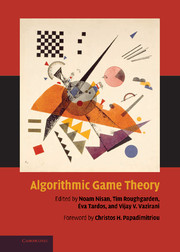Book contents
- Frontmatter
- Contents
- Foreword
- Preface
- Contributors
- I Computing in Games
- 1 Basic Solution Concepts and Computational Issues
- 2 The Complexity of Finding Nash Equilibria
- 3 Equilibrium Computation for Two-Player Games in Strategic and Extensive Form
- 4 Learning, Regret Minimization, and Equilibria
- 5 Combinatorial Algorithms for Market Equilibria
- 6 Computation of Market Equilibria by Convex Programming
- 7 Graphical Games
- 8 Cryptography and Game Theory
- II Algorithmic Mechanism Design
- III Quantifying the Inefficiency of Equilibria
- IV Additional Topics
- Index
7 - Graphical Games
from I - Computing in Games
Published online by Cambridge University Press: 31 January 2011
- Frontmatter
- Contents
- Foreword
- Preface
- Contributors
- I Computing in Games
- 1 Basic Solution Concepts and Computational Issues
- 2 The Complexity of Finding Nash Equilibria
- 3 Equilibrium Computation for Two-Player Games in Strategic and Extensive Form
- 4 Learning, Regret Minimization, and Equilibria
- 5 Combinatorial Algorithms for Market Equilibria
- 6 Computation of Market Equilibria by Convex Programming
- 7 Graphical Games
- 8 Cryptography and Game Theory
- II Algorithmic Mechanism Design
- III Quantifying the Inefficiency of Equilibria
- IV Additional Topics
- Index
Summary
Abstract
In this chapter we examine the representational and algorithmic aspects of a class of graph-theoretic models for multiplayer games. Known broadly as graphical games, these models specify restrictions on the direct payoff influences among the player population. In addition to a number of nice computational properties, these models have close connections to well-studied graphical models for probabilistic inference in machine learning and statistics.
Introduction
Representing multiplayer games with large player populations in the normal form is undesirable for both practical and conceptual reasons. On the practical side, the number of parameters that must be specified grows exponentially with the size of the population. On the conceptual side, the normal form may fail to capture structure that is present in the strategic interaction, and which can aid understanding of the game and computation of its equilibria. For this reason, there have been many proposals for parametric multiplayer game representations that are more succinct than the normal form, and attempt to model naturally arising structural properties. Examples include congestion and potential games and related models (Monderer and Shapley, 1996; Rosenthal, 1973).
Graphical games are a representation of multiplayer games meant to capture and exploit locality or sparsity of direct influences. They are most appropriate for large population games in which the payoffs of each player are determined by the actions of only a small subpopulation. As such, they form a natural counterpart to earlier parametric models.
- Type
- Chapter
- Information
- Algorithmic Game Theory , pp. 159 - 180Publisher: Cambridge University PressPrint publication year: 2007
- 32
- Cited by



